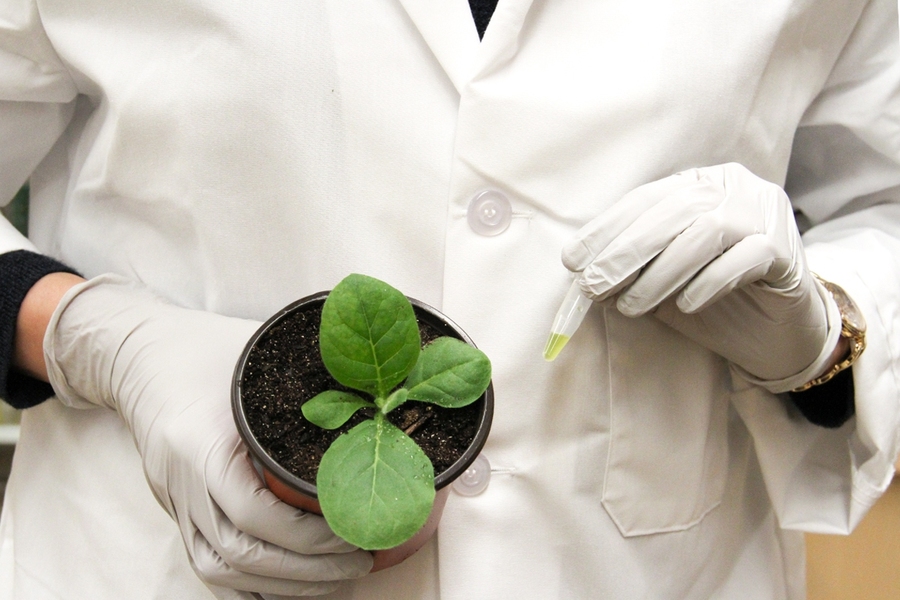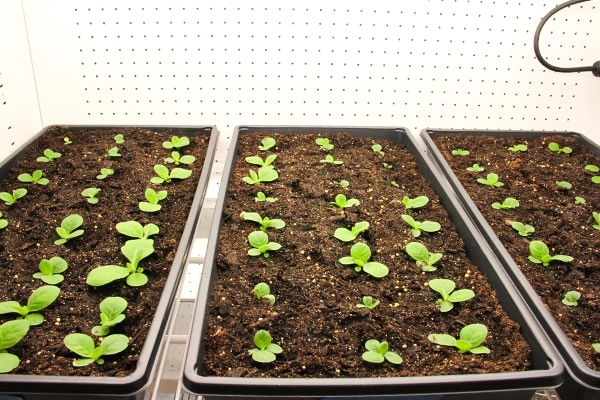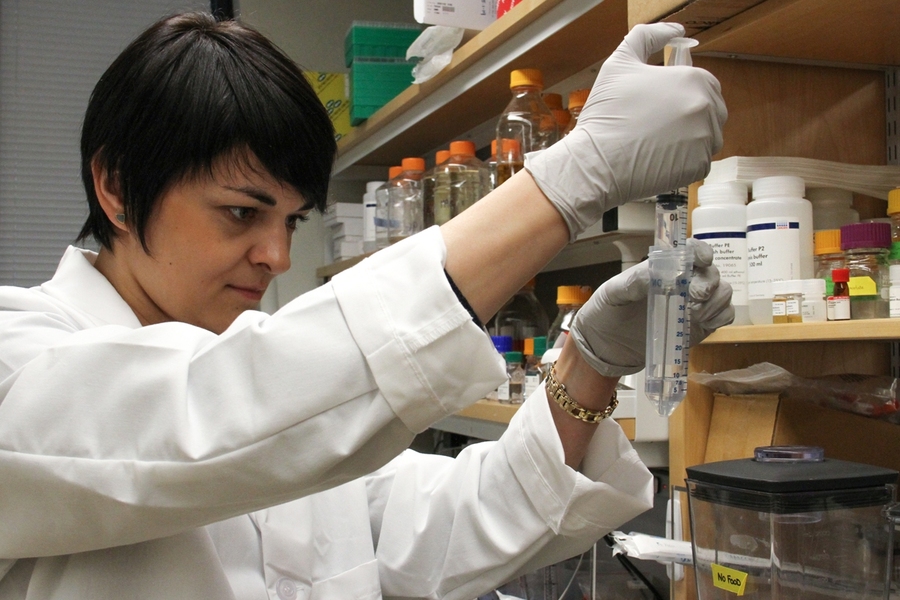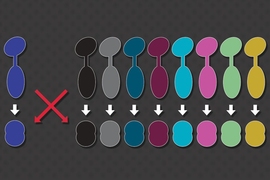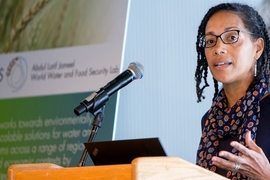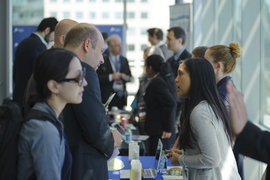As food demand rises due to growing and changing populations around the world, increasing crop production has been a vital target for agriculture and food systems researchers who are working to ensure there is enough food to meet global need in the coming years. One MIT research group mobilizing around this challenge is the Voigt lab in the Department of Biological Engineering, led by Christopher Voigt, the Daniel I.C. Wang Professor of Advanced Biotechnology at MIT.
For the past four years, the Abdul Latif Jameel Water and Food Systems Lab (J-WAFS) has funded Voigt with two J-WAFS Seed Grants. With this support, Voigt and his team are working on a significant and longstanding research challenge: transform cereal crops so they are able to fix their own nitrogen.
Chemical fertilizer: how it helps and hurts
Nitrogen is a key nutrient that enables plants to grow. Plants like legumes are able to provide their own through a symbiotic relationship with bacteria that are capable of fixing nitrogen from the air and putting it into the soil, which is then drawn up by the plants through their roots. Other types of crops — including major food crops such as corn, wheat, and rice — typically rely on added fertilizers for nitrogen, including manure, compost, and chemical fertilizers. Without these, the plants that grow are smaller and produce less grain.
Over 3.5 billion people today depend on chemical fertilizers for their food. Eighty percent of chemical nitrogen fertilizers today are made using the Haber-Borsch process, which involves transforming nitrile gas into ammonia. While nitrogen fertilizer has boosted agriculture production in the last century, this has come with some significant costs. First, the Haber-Borsch process itself is very energy- and fossil fuel-intensive, making it unsustainable in the face of a rapidly changing climate. Second, using too much chemical fertilizer results in nitrogen pollution. Fertilizer runoff pollutes rivers and oceans, resulting in algae blooms that suffocate marine life. Cleaning up this pollution and paying for the public health and environmental damage costs the United States $157 billion annually. Third, when it comes to chemical fertilizers, there are problems with equity and access. These fertilizers are made in the northern hemisphere by major industrialized nations, where postash, a main ingredient, is abundant. However, transportation costs are high, especially to countries in the southern hemisphere. So, for farmers in poorer regions, this barrier results in lower crop yield.
These environmental and societal challenges pose large problems, yet farmers still need to apply nitrogen to maintain the necessary agriculture productivity to meet the world’s food needs, especially as population and climate change stress the world’s food supplies. So, fertilizers are and will continue to be a critical tool.
But, might there be another way?
The bacterial compatability of chloroplasts and mitochondria
This is the question that drives researchers in the Voigt lab, as they work to develop nitrogen-fixing cereal grains. The strategy they have developed is to target the specific genes in the nitrogen-fixing bacteria that operate symbiotically with legumes, called the nif genes. These genes cause the expression of the protein structures (nitrogenase clusters) that fix nitrogen from the air. If these genes were able to be successfully transferred and expressed in cereal crops, chemical fertilizers would no longer be needed to add needed nitrogen, as these crops would be able to obtain nitrogen themselves.
This genetic engineering work has long been regarded as a major technical challenge, however. The nif pathway is very large and involves many different genes. Transferring any large gene cluster is itself a difficult task, but there is added complexity in this particular pathway. The nif genes in microbes are controlled by a precise system of interconnected genetic parts. In order to successfully transfer the pathway’s nitrogen-fixing capabilities, researchers not only have to transfer the genes themselves, but also replicate the cellular components responsible for controlling the pathway.
This leads into another challenge. The microbes responsible for nitrogen fixation in legumes are bacteria (prokaryotes), and, as explained by Eszter Majer, a postdoc in the Voigt lab who has been working on the project for the past two years, “the gene expression is completely different in plants, which are eukaryotes.” For example, prokaryotes organize their genes into operons, a genetic organization system that does not exist in eukaryotes such as the tobacco leaves the Voigt is using in its experiments. Reengineering the nif pathway in a eukaryote is tantamount to a complete system overhaul.
The Voigt lab has found a workaround: Rather than target the entire plant cell, they are targetting organelles within the cell — specifically, the chloroplasts and the mitochondria. Mitochondria and chloroplasts both have ancient bacterial origins and once lived independently outside of eukaryotic cells as prokaryotes. Millions of years ago, they were incorporated into the eukaryotic system as organelles. They are unique in that they have their own genetic data and have also maintained many similarities to modern-day prokaryotes. As a result, they are excellent candidates for nitrogenase transfer. Majer explains, “It’s much easier to transfer from a prokaryote to a prokaryote-like system than reengineer the whole pathway and try to transfer to a eukaryote.”
Beyond gene structure, these organelles have additional attributes that make them suitable environments for nitrogenase clusters to function. Nitrogenase requires a lot of energy to function and both chloroplasts and mitochondria already produce high amounts energy — in the form of ATP — for the cell. Nitrogenase is also very sensitive to oxygen and will not function if there is too much of it in its environment. However, chloroplasts at night and mitochondria in plants have low-oxygen levels, making them an ideal location for the nitrogenase protein to operate.
An international team of experts
While the team found devised an approach for transforming eukaryotic cells, their project still involved highly technical biological engineering challenges. Thanks to the J-WAFS grants, the Voigt lab has been able to collaborate with two specialists at overseas universities to obtain critical expertise..
One was Luis Rubio, an associate professor focusing on the biochemistry of nitrogen fixation at the Polytechnic University of Madrid, Spain. Rubio is an expert in nitrogenase and nitrogen-inspired chemistry. Transforming mitochondrial DNA is a challenging process, so the team designed a nitrogenase gene delivery system using yeast. Yeast are easy eukaryotic organisms to engineer and can be used to target the mitochondria. The team inserted the nitrogenase genes into the yeast nuclei, which are then targeted to mitochondria using peptide fusions. This research resulted in the first eukaryotic organism to demonstrate the formation of nitrogenase structural proteins.
The Voigt lab also collaborated with Ralph Bock, a chloroplast expert from the Max Planck Institute of Molecular Plant Physiology in Germany. He and the Voigt team have made great strides toward the goal of nitrogen-fixing cereal crops; the details of their recent accomplishments advancing the field crop engineering and furthering the nitrogen-fixing work will be published in the coming months.
Continuing in pursuit of the dream
The Voigt lab, with the support of J-WAFS and the invaluable international collaboration that has resulted, was able to obtain groundbreaking results, moving us closer to fertilizer independence through nitrogen-fixing cereals. They made headway in targeting nitrogenase to mitochondria and were able to express a complete NifDK tetramer — a key protein in the nitrogenase cluster — in yeast mitochondria. Despite these milestones, more work is yet to be done.
“The Voigt lab is invested in moving this research forward in order to get ever closer to the dream of creating nitrogen-fixing cereal crops,“ says Chris Voigt. With these milestones under their belt, these researchers have made great advances, and will continue to push torward the realization of this transformative vision, one that could revolutionize cereal production globally.
